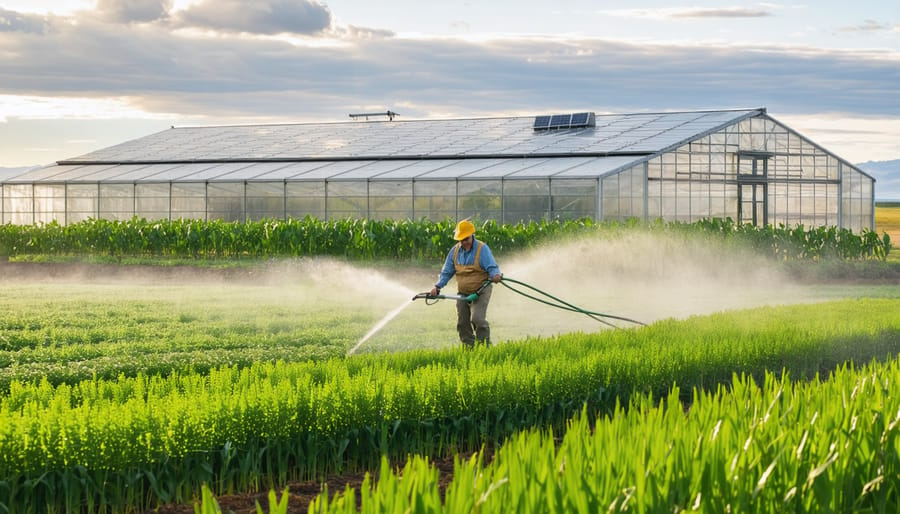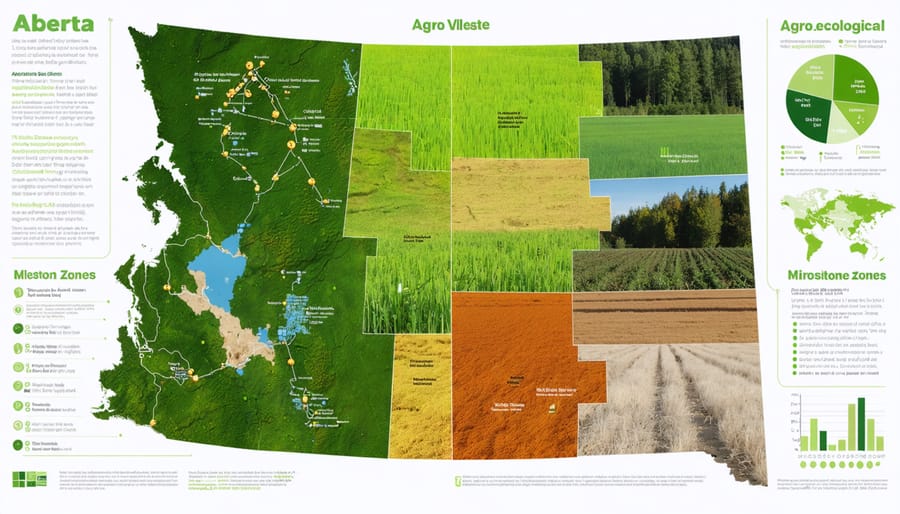Implement no-till farming to minimize soil disturbance, reduce erosion, and improve soil health. Plant cover crops to protect and enrich the soil, suppress weeds, and provide forage for livestock. Adopt crop rotation to optimize nutrient cycling, break pest and disease cycles, and increase biodiversity. Utilize precision agriculture technologies like GPS guidance, variable rate application, and remote sensing to optimize inputs and minimize environmental impact.

Adopting Conservation Tillage
Success Story: Farmer John’s No-Till Journey
Meet Farmer John, a third-generation grain farmer from Lethbridge, Alberta. Six years ago, John decided to embark on a journey to implement no-till practices on his 2,000-acre farm. Initially skeptical, John was convinced by the potential benefits of reduced soil erosion, improved moisture retention, and lower fuel costs.
The transition wasn’t without challenges. John had to invest in new equipment, such as a no-till drill, and learn new techniques for managing weeds and crop residue. However, with support from local agricultural organizations and fellow farmers, John persevered.
Today, John’s fields are thriving. His soil organic matter has increased by 2%, water infiltration rates have doubled, and he’s saving an average of 10 liters of diesel fuel per hectare annually. Moreover, John has noticed an increase in beneficial insects and wildlife on his land.
John’s success story is a testament to the power of embracing change and prioritizing soil health. His experience has inspired neighboring farmers to explore no-till practices, fostering a growing community of climate-smart agriculture advocates in southern Alberta.
Embracing Cover Crops

Top Cover Crop Choices for Alberta Farms
Here are some top cover crop choices well-suited for Alberta’s climate and soil conditions:
Winter cereals like fall rye, winter wheat, and winter triticale provide excellent ground cover, reduce erosion, and scavenge excess nutrients. Legumes such as alfalfa, sweet clover, and field peas fix atmospheric nitrogen, improving soil fertility. Brassicas like turnips, radishes, and rapeseed have deep taproots that break up compacted soils and recycle nutrients from lower soil layers.
Other options include buckwheat, a fast-growing summer cover that suppresses weeds and loosens topsoil, and phacelia, which attracts beneficial insects. Oats are another popular choice, often paired with peas in a classic cover crop mix.
When selecting cover crops, consider your farm’s specific needs, such as improving soil structure, providing forage, or preparing land for a subsequent crop. Consult with local agricultural extension services or experienced farmers to determine the best options for your operation.
Implementing Crop Rotation
Implementing diverse crop rotations is a cornerstone of climate-smart agriculture, offering numerous benefits for soil health, pest and disease management, and overall farm resilience. By alternating between different crop types, such as legumes, cereals, and oilseeds, farmers can improve soil structure, fertility, and organic matter content. Legumes, in particular, play a crucial role by fixing atmospheric nitrogen and reducing the need for synthetic fertilizers. This not only saves costs but also minimizes greenhouse gas emissions associated with fertilizer production and application.
Crop rotations also help break pest and disease cycles, reducing the reliance on chemical interventions and promoting a more balanced agroecosystem. By disrupting the life cycles of harmful organisms, rotations can prevent their populations from building up to damaging levels. This natural form of pest and disease control enhances the farm’s climate resilience by minimizing the risk of crop failures and yield losses due to biotic stresses.
Furthermore, diverse rotations contribute to a more robust and resilient soil microbiome. By providing a variety of plant residues and root exudates, rotations support a diverse community of soil organisms, which in turn improve nutrient cycling, soil aggregation, and water retention. These benefits are particularly valuable in the face of climate change, as they enhance the soil’s capacity to withstand drought, heavy rainfall events, and temperature extremes.
To maximize the benefits of crop rotations, Alberta farmers should consider factors such as their local climate, soil type, and market demands when designing their rotation plans. Seeking advice from experienced practitioners, agricultural extension services, and local farmer networks can provide valuable insights and support in implementing this essential climate-smart practice.
Integrating Livestock and Cropping Systems
Integrating livestock and cropping systems offers a promising approach for Alberta farmers to enhance soil health, sequester carbon, and diversify their income streams. By combining livestock grazing with crop production, farmers can capitalize on the natural synergies between these systems. Livestock manure provides valuable organic matter and nutrients to the soil, improving its structure and fertility. This, in turn, can boost crop yields and reduce the need for synthetic fertilizers. Grazing animals on crop residues and cover crops also helps to cycle nutrients, control weeds, and stimulate plant growth.
Moreover, integrated crop-livestock systems can play a significant role in carbon sequestration. Well-managed pastures and grasslands have the potential to store substantial amounts of carbon in their soils and biomass. By incorporating perennial forages and carefully planned grazing into cropping rotations, farmers can increase soil organic matter and offset greenhouse gas emissions. These practices not only contribute to climate change mitigation but also enhance the overall resilience of agricultural land.
Economically, integrating livestock and crops can provide farmers with a more stable and diversified income. Livestock products, such as meat, milk, and eggs, offer additional revenue streams alongside crop sales. This diversity can help buffer against market fluctuations and unexpected weather events. Furthermore, by producing a portion of their own livestock feed through crop residues and forages, farmers can reduce their reliance on purchased inputs and increase their self-sufficiency.
To successfully implement an integrated crop-livestock system, careful planning and management are essential. Alberta farmers can start by assessing their land’s suitability for grazing, selecting appropriate livestock species and stocking rates, and designing a rotational grazing plan that complements their crop production. Seeking guidance from experienced practitioners, attending workshops, and collaborating with local agricultural organizations can provide valuable support in this transition.
Precision Agriculture Technologies

Getting Started with Precision Ag on a Budget
Getting started with precision agriculture on a budget can feel daunting, but there are practical ways to adopt these technologies incrementally. Begin by investing in a basic GPS guidance system for your tractor, which can improve efficiency and reduce overlap during field operations. Many affordable options are available, and some can even use your existing smartphone or tablet.
Next, consider soil sampling and mapping. While full-scale grid sampling may be costly, you can start with zone sampling based on field characteristics or historical yield data. This will provide valuable insights into soil variability and nutrient needs, allowing for more targeted input application.
Collecting and analyzing yield data is another accessible entry point. Many newer combines have built-in yield monitors, but you can also retrofit older models with aftermarket systems. By understanding yield variations within your fields, you can make data-driven decisions about management practices.
As you become more comfortable with precision ag technologies, you can gradually add more advanced tools like variable rate application equipment and remote sensing. Remember, the key is to start small, learn as you go, and invest in the technologies that will provide the most benefit for your specific operation. By taking an incremental approach, you can reap the rewards of precision agriculture without breaking the bank.
Agroforestry Opportunities
Agroforestry, the integration of trees and shrubs into agricultural systems, offers Alberta farmers a powerful tool for climate change mitigation and adaptation. By implementing agroforestry practices such as shelterbelts and silvopasture, farmers can sequester significant amounts of carbon while enhancing the resilience of their land.
Shelterbelts, strategically planted rows of trees and shrubs, act as windbreaks, reducing soil erosion and protecting crops from harsh weather conditions. These living fences also provide habitat for beneficial insects and wildlife, promoting biodiversity on the farm. As they grow, the trees in shelterbelts absorb and store atmospheric carbon in their biomass and the soil, contributing to climate change mitigation.
Silvopasture, the integration of trees with livestock grazing, is another promising agroforestry approach. By providing shade and shelter for animals, trees reduce heat stress and improve animal welfare. The deep root systems of trees also help to prevent soil compaction and enhance nutrient cycling. Over time, the trees in silvopasture systems can sequester substantial amounts of carbon, offsetting greenhouse gas emissions from the livestock sector.
Adopting agroforestry practices not only benefits the environment but also offers economic opportunities for Alberta farmers. Diversifying agricultural systems with tree crops, such as fruit and nut trees, can provide additional income streams and reduce the risks associated with relying on a single crop or livestock species. As consumers increasingly demand sustainable and ethically produced food, agroforestry can help farmers meet this growing market demand.
Conclusion
Climate-smart agricultural practices offer Alberta farmers a path to a more sustainable and resilient future. By adopting strategies like conservation tillage, cover cropping, and precision agriculture, farmers can reduce their environmental impact while improving soil health, water efficiency, and crop yields. Implementing these practices not only benefits the planet but also supports long-term farm profitability and resilience in the face of climate change. As stewards of the land, Alberta farmers have a unique opportunity to lead the way in sustainable agriculture. By working together, sharing knowledge, and embracing climate-smart practices, we can build a thriving agricultural community that nourishes both people and the planet for generations to come. The journey to sustainability starts with small steps, and every farmer can make a difference. Let’s unite in our commitment to climate-smart agriculture and create a brighter, greener future for Alberta’s farms and beyond.











